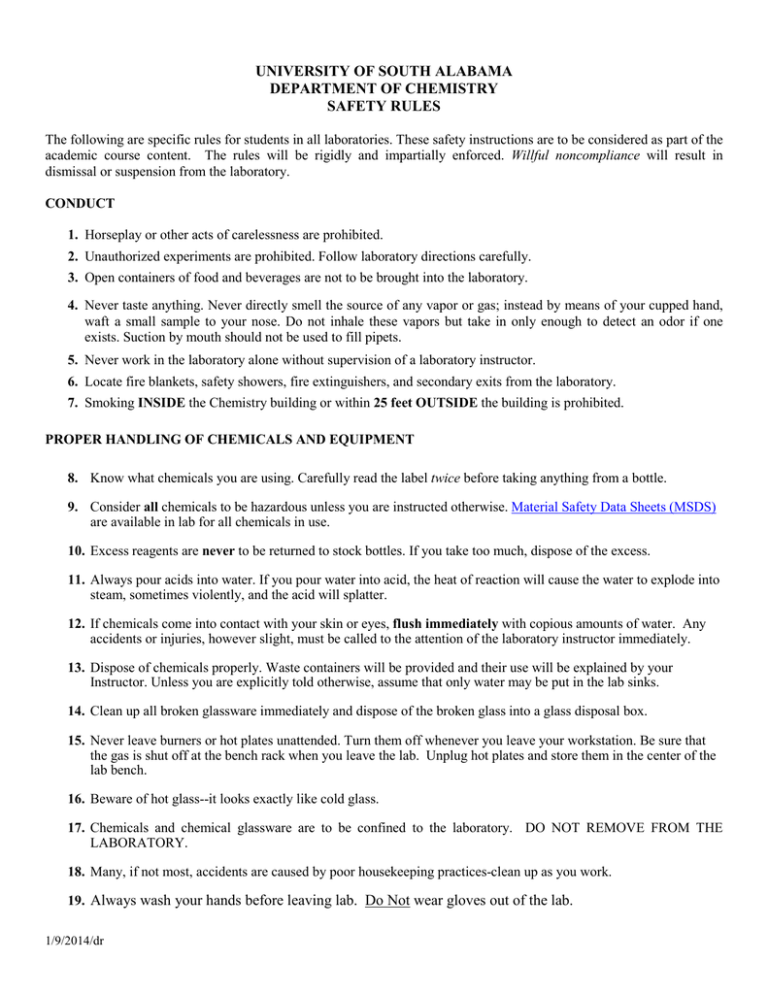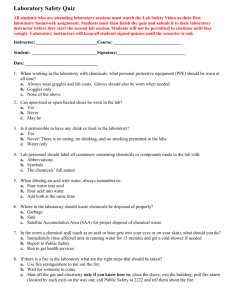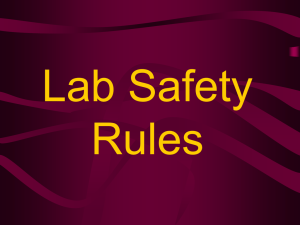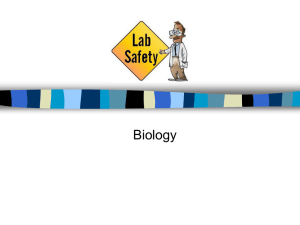UNIVERSITY OF SOUTH ALABAMA DEPARTMENT OF CHEMISTRY SAFETY RULES
advertisement

UNIVERSITY OF SOUTH ALABAMA DEPARTMENT OF CHEMISTRY SAFETY RULES The following are specific rules for students in all laboratories. These safety instructions are to be considered as part of the academic course content. The rules will be rigidly and impartially enforced. Willful noncompliance will result in dismissal or suspension from the laboratory. CONDUCT 1. Horseplay or other acts of carelessness are prohibited. 2. Unauthorized experiments are prohibited. Follow laboratory directions carefully. 3. Open containers of food and beverages are not to be brought into the laboratory. 4. Never taste anything. Never directly smell the source of any vapor or gas; instead by means of your cupped hand, waft a small sample to your nose. Do not inhale these vapors but take in only enough to detect an odor if one exists. Suction by mouth should not be used to fill pipets. 5. Never work in the laboratory alone without supervision of a laboratory instructor. 6. Locate fire blankets, safety showers, fire extinguishers, and secondary exits from the laboratory. 7. Smoking INSIDE the Chemistry building or within 25 feet OUTSIDE the building is prohibited. PROPER HANDLING OF CHEMICALS AND EQUIPMENT 8. Know what chemicals you are using. Carefully read the label twice before taking anything from a bottle. 9. Consider all chemicals to be hazardous unless you are instructed otherwise. Material Safety Data Sheets (MSDS) are available in lab for all chemicals in use. 10. Excess reagents are never to be returned to stock bottles. If you take too much, dispose of the excess. 11. Always pour acids into water. If you pour water into acid, the heat of reaction will cause the water to explode into steam, sometimes violently, and the acid will splatter. 12. If chemicals come into contact with your skin or eyes, flush immediately with copious amounts of water. Any accidents or injuries, however slight, must be called to the attention of the laboratory instructor immediately. 13. Dispose of chemicals properly. Waste containers will be provided and their use will be explained by your Instructor. Unless you are explicitly told otherwise, assume that only water may be put in the lab sinks. 14. Clean up all broken glassware immediately and dispose of the broken glass into a glass disposal box. 15. Never leave burners or hot plates unattended. Turn them off whenever you leave your workstation. Be sure that the gas is shut off at the bench rack when you leave the lab. Unplug hot plates and store them in the center of the lab bench. 16. Beware of hot glass--it looks exactly like cold glass. 17. Chemicals and chemical glassware are to be confined to the laboratory. DO NOT REMOVE FROM THE LABORATORY. 18. Many, if not most, accidents are caused by poor housekeeping practices-clean up as you work. 19. Always wash your hands before leaving lab. Do Not wear gloves out of the lab. 1/9/2014/dr ATTIRE 20. Goggles are required at all times in the laboratory. This includes whether you are actually working on an experiment, washing glassware, or writing in your lab manual. Goggles must be OSHA approved, splash-proof, indirectly vented, and fitted close to the face. A student wearing contact lenses should inform his/her instructor. 21. Personal items, i.e. coats, backpacks, etc., are not to be kept at the lab bench. There are shelves and hook racks just inside the entrance to the lab. Beware that lab chemicals can destroy personal possessions. 22. Confine long hair behind head and shoulders when in the laboratory. 23. You must be properly dressed to attend laboratory. Exceptions for religious purposes must be addressed with the Laboratory Manager. Lab coats or lab aprons are acceptable and encouraged, but do not replace the clothing requirement. YES NO Goggles OSHA approved, indirectly vented, splash- Safety glasses with side shields or directly proof, and fitted close to the face. vented goggles. Pants Tight fitting pants of any type, capris, shorts, Standard trousers, jeans, khakis, scrubs, etc. of skorts, skirts (even long ones), leggings, cotton or polyester/cotton blend. No synthetics. Jeggings, stocking-type exercise tights. Should not have holes, rips, or tears. No dragging on Must cover the body from waist to ankle. the floor or low-hanging style. Shirts Sleeve sufficient to cover at least half of arm Tank tops, sleeveless, or midriff baring, lowfrom shoulder to elbow. Long enough to stay cut or open back. tucked-in or down, so no bare midriff Shoes Flip-flops, sandals, web-type, ballerina/slipper Sturdy, substantial shoes which cover the full type shoes. Toes must be completely covered. top of the foot. Backless shoes are acceptable. Avoid cloth shoes. High heels are discouraged. Hair / Hats Secure (tie back) long hair behind head and shoulders. Hats, caps, scarfs, head coverings of any type. You will be exposed to chemicals in lab. Some of them can cause serious damage to your body due to exposure. If you have any doubts about the appropriateness of your clothing, don’t wear it!!! Use good judgment. Select a “lab uniform” and stick with it! Don’t make yourself an accident waiting to happen. 1/9/2014/dr




